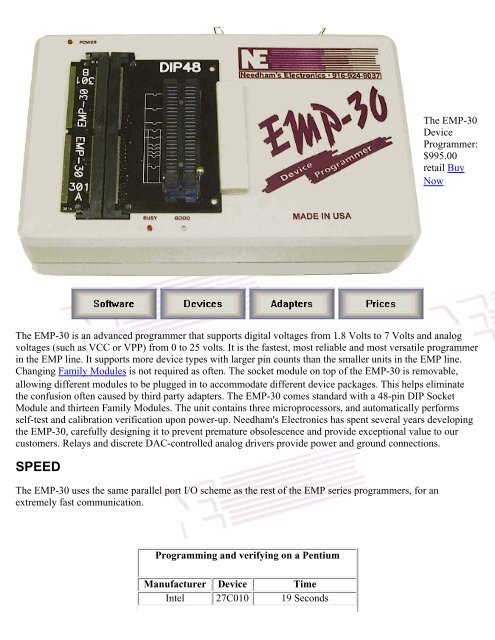EMP-30 Device Programmer - ELS electronic
EMP-30 Device Programmer - ELS electronic EMP-30 Device Programmer - ELS electronic
The EMP-30 Device Programmer: $995.00 retail Buy Now The EMP-30 is an advanced programmer that supports digital voltages from 1.8 Volts to 7 Volts and analog voltages (such as VCC or VPP) from 0 to 25 volts. It is the fastest, most reliable and most versatile programmer in the EMP line. It supports more device types with larger pin counts than the smaller units in the EMP line. Changing Family Modules is not required as often. The socket module on top of the EMP-30 is removable, allowing different modules to be plugged in to accommodate different device packages. This helps eliminate the confusion often caused by third party adapters. The EMP-30 comes standard with a 48-pin DIP Socket Module and thirteen Family Modules. The unit contains three microprocessors, and automatically performs self-test and calibration verification upon power-up. Needham's Electronics has spent several years developing the EMP-30, carefully designing it to prevent premature obsolescence and provide exceptional value to our customers. Relays and discrete DAC-controlled analog drivers provide power and ground connections. SPEED The EMP-30 uses the same parallel port I/O scheme as the rest of the EMP series programmers, for an extremely fast communication. Programming and verifying on a Pentium Manufacturer Device Time Intel 27C010 19 Seconds
- Page 2 and 3: PORTABILITY Lattice 22V10 3 Seconds
The <strong>EMP</strong>-<strong>30</strong><br />
<strong>Device</strong><br />
<strong>Programmer</strong>:<br />
$995.00<br />
retail Buy<br />
Now<br />
The <strong>EMP</strong>-<strong>30</strong> is an advanced programmer that supports digital voltages from 1.8 Volts to 7 Volts and analog<br />
voltages (such as VCC or VPP) from 0 to 25 volts. It is the fastest, most reliable and most versatile programmer<br />
in the <strong>EMP</strong> line. It supports more device types with larger pin counts than the smaller units in the <strong>EMP</strong> line.<br />
Changing Family Modules is not required as often. The socket module on top of the <strong>EMP</strong>-<strong>30</strong> is removable,<br />
allowing different modules to be plugged in to accommodate different device packages. This helps eliminate<br />
the confusion often caused by third party adapters. The <strong>EMP</strong>-<strong>30</strong> comes standard with a 48-pin DIP Socket<br />
Module and thirteen Family Modules. The unit contains three microprocessors, and automatically performs<br />
self-test and calibration verification upon power-up. Needham's Electronics has spent several years developing<br />
the <strong>EMP</strong>-<strong>30</strong>, carefully designing it to prevent premature obsolescence and provide exceptional value to our<br />
customers. Relays and discrete DAC-controlled analog drivers provide power and ground connections.<br />
SPEED<br />
The <strong>EMP</strong>-<strong>30</strong> uses the same parallel port I/O scheme as the rest of the <strong>EMP</strong> series programmers, for an<br />
extremely fast communication.<br />
Programming and verifying on a Pentium<br />
Manufacturer <strong>Device</strong> Time<br />
Intel 27C010 19 Seconds
PORTABILITY<br />
Lattice 22V10 3 Seconds<br />
Atmel 89C51 7 Seconds<br />
With it's added versatility, the <strong>EMP</strong>-<strong>30</strong> is larger than our other programmers, but it is still quite portable; since<br />
it doesn't fit inside your PC, you can pack it up and take it with you anytime you wish, and use it with any<br />
standard parallel port. The programmer, parallel cable, transformer, thirteen Family Modules, and DIP-48<br />
Socket Module weigh about 7 pounds.<br />
STABILITY<br />
●<br />
●<br />
●<br />
●<br />
The <strong>EMP</strong>-<strong>30</strong> carries a 1 year warranty on all parts and labor, and a <strong>30</strong> day money-back guarantee<br />
(restocking fee may apply)<br />
The <strong>EMP</strong>-<strong>30</strong> is static-protected at the Adapter Socket, Family Module socket, parallel port, and power<br />
connector. The static protection on the parallel port also gives it under and over voltage protection.<br />
It's case is made of tough .125" thick ABS plastic.<br />
Compliant, for sale into the European Community.<br />
FAMILY MODULES<br />
Family Modules are not an entirely new idea. They have been used in other<br />
programmers from time to time, to inexpensively route power and ground to the<br />
device. When you're programming devices fairly slow, then straight, slide-in<br />
connectors are just fine. However, the <strong>EMP</strong>-<strong>30</strong> programs at speeds near the<br />
theoretical maximum of some devices, so the digital signals traveling to the device<br />
must be clean, and the power and ground lines must be solid. Slide-in connectors<br />
can experience noise problems, higher resistance, and corrosion.<br />
The purpose of Family modules is to allow us to use a few high quality pin drivers,<br />
instead of using a cheaper pin driver on each pin on the Adapter Socket. This translates to cleaner, more<br />
manageable waveforms, at a much lower price.<br />
SYSTEM REQUIREMENTS<br />
To use the <strong>EMP</strong>-<strong>30</strong>, you must have the following:
●<br />
●<br />
●<br />
●<br />
Operating System: An IBM-Compatible PC, Windows 95 or above, with 16Mb of RAM<br />
Hard Drive Space: At least 40Mb of free space<br />
Interface: A standard parallel port<br />
Power: 12-16 Volts @ 2.5 Amp, AC or DC<br />
INCLUDED ITEMS<br />
●<br />
●<br />
●<br />
●<br />
A standard parallel port cable<br />
A DIP-48 socket adapter<br />
An AC 110V transformer ( a 220V transformer at additional cost is available upon request)<br />
Numbers <strong>30</strong>0-312 Family modules are included with the <strong>EMP</strong>-<strong>30</strong>, in a small carrying wallet



